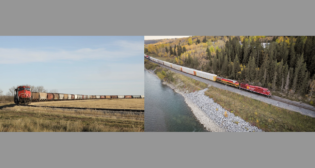
STB Calculates Five-Year Change in Railroad Productivity
Written by Marybeth Luczak, Executive Editor
The Surface Transportation Board (STB) on Jan. 18 presented its calculation for the change in railroad productivity for the 2018-2022 averaging period. Comments are due by Feb. 5.
According to the agency, each year it calculates the change, if any, in how efficiently railroads move freight. The STB calculates this figure by comparing year-to-year the average cost of producing a unit of railroad output.
The STB proposes to adopt 1.011 (1.1% per year) as the measure of average (geometric mean) change in railroad productivity for the 2018-2022 (five-year) period (download decision below). This represents a decrease of 1.6% from the average for the 2017-2021 period, it said.
According to the STB, the cost recovery procedures since 1989 have required that the quarterly rail cost adjustment factor (RCAF) be adjusted for long-run changes in railroad productivity. (For more, read: “STB Sets 1Q24 Rail Cost Adjustment Factor.”) “This long-run measure of productivity is computed using a five-year moving geometric average,” it explained. “The productivity change for the year 2022 is 0.972, based on changes in input and output levels from 2021, and represents a decrease of 5.6% from the rate of productivity growth in 2021 relative to 2020 (1.029). Incorporating the 2022 value with the values for the 2018-2021 period produces a geometric average productivity growth of 1.011 for the five-year period 2018-2022, or 1.1% per year. As the new geometric mean was computed by replacing the 2017 figure of 1.053 with the smaller figure of 0.972 for 2022, there was a decrease of 1.6% in the geometric mean from last year’s value.”
The STB is requesting comments by Feb. 5 “addressing any perceived data and computational errors” in its calculation. It noted that “[a]ny party proposing a different estimate of productivity growth must, at the time it files comments, furnish the Board with one set of detailed workpapers and documentation underlying its calculations.”



